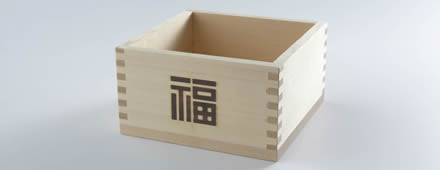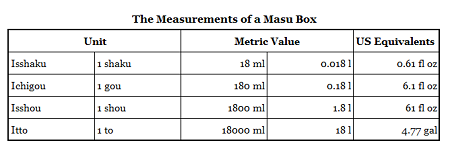Traditional Masu


Masu boxes are made in accordance with traditional measurements that are still used to measure Sake today. The volume of each size is as follows:
- ・Goshaku Masu (67mm×67mm×47mm)
- ・Hasshaku Masu (82mm×82mm×51mm)
- ・Ichigou Masu (85mm×85mm×56mm)
- ・Nigouhan Masu (115mm×115mm×64mm)
- ・Gogou Masu (140mm×140mm×76mm)
- ・Isshou Masu (172mm×172mm×93mm)
The Masu box has been in use for over 1300 years. The traditional sizes of the Masu box were regulated some 500 years ago and have not changed since.
There are three traditional units in Japan. They are called the Shaku, the Gou, and the Shou. The size of these units get bigger in this order. (…Learn more at “About Masu”)
1 Gou or Ichigou , is 10 Shaku, at approximately 180ml.
1 Shou is 10 Gou, which is about 1800ml or 1.8 liters.
1 Shaku, or Isshaku, as said in Japanese, is roughly equivalent to 18ml.
Originally a measuring cup for foods such as rice and soy sauce, the Masu was used to measure rice when it was still used as a form of currency. For the Japanese people, the Masu was as valuable and important as the rice it contained, and this tradition remains crucial to the lives of the Japanese to this very day.
More recently, the Masu has become widely acknowledged as a vessel for serving Sake, as well as a symbol of good luck. The term “Masu” translates to “growth” in Japanese, and is thus an icon of prosperity and great happiness.
The Masu box is an extremely versatile instrument. Besides from being a token of good luck, it has traditionally been used as a measuring cup and a sake vessel. Masu is also an ideal item for keeping accessories, holding a memo pad, or as a gift of celebration. Your imagination is the limit when it comes to inventing creative ways to use the Masu box.
In what situations would you use a Masu box?
There are three traditional units in Japan. They are called the Shaku, the Gou, and the Shou. The size of these units get bigger in this order. (…Learn more at “About Masu”)
1 Gou or Ichigou , is 10 Shaku, at approximately 180ml.
1 Shou is 10 Gou, which is about 1800ml or 1.8 liters.
1 Shaku, or Isshaku, as said in Japanese, is roughly equivalent to 18ml.
Originally a measuring cup for foods such as rice and soy sauce, the Masu was used to measure rice when it was still used as a form of currency. For the Japanese people, the Masu was as valuable and important as the rice it contained, and this tradition remains crucial to the lives of the Japanese to this very day.
More recently, the Masu has become widely acknowledged as a vessel for serving Sake, as well as a symbol of good luck. The term “Masu” translates to “growth” in Japanese, and is thus an icon of prosperity and great happiness.
The Masu box is an extremely versatile instrument. Besides from being a token of good luck, it has traditionally been used as a measuring cup and a sake vessel. Masu is also an ideal item for keeping accessories, holding a memo pad, or as a gift of celebration. Your imagination is the limit when it comes to inventing creative ways to use the Masu box.
In what situations would you use a Masu box?
Masu for Special Occasions

In Japan, Masu boxes sizes Sanjyaku (three Shaku) to Ichigou (1 Gou) are commonly used as sake vessels and cups at weddings and celebrative parties.
The larger Nigouhan (2.5 Gou). Gogou (Five Gou), and Isshou (1 Shou) boxes are reserved for measuring food, or as ritualistic instruments for Shinto practices.
Make Yourself a One-and-Only Masu Box

Branded or laser printed Masu boxes that bear the names of companies or individuals serve as a perfect souvenir for special occasions.
We are ready to meet whatever requests you might have.
Feel free to contact us if you are interested in making your own unique Masu.
We are ready to meet whatever requests you might have.
Feel free to contact us if you are interested in making your own unique Masu.
© copyright
Ohashi
